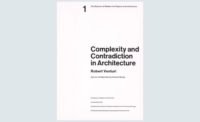“It’s like a gathering to decipher the Talmud,” architectural historian Jean-Louis Cohen observed at a three-day symposium of scholars, architects, and students discussing Robert Venturi’s famous opus, Complexity and Contradiction in Architecture, published 50 years ago.
The well-attended colloquium held at New York’s Museum of Modern Art (MoMA), the Philadelphia Museum of Art, and the Architectural Archives at the University of Pennsylvania took place November 10 to 12. During the symposium, both the book and its ideas were held up to intense scrutiny. The numerous presenting scholars analyzed the input from Venturi’s coterie of readers and editors to shed new light on the outside influences on this seminal text.
Missing from the proceedings was the author himself, now in declining health. But insights from archives and interviews abounded. Still, certain aspects of the book’s rite of passage would have benefitted from both the presence of Venturi or the late Arthur Drexler, director of the architecture and design department when MoMA originally published the slim volume under his strong tutelage. (Memo to self: Keep notes on every decision. You never know.)
Martino Stierli, the Philip Johnson chief curator of architecture and design at MoMA, pointed out that while Complexity and Contradiction was a formalist critique of modern architecture as it had evolved in the post-war period, it had “the full support of the institution that Venturi set out to criticize.” (He didn’t need to remind the assembled throng that MoMA was the home of the landmark 1932 show on the International Style.)
Stierli also said he found the general perception of the book—that it is a rejection of modernism—not to be quite the case: rather, it was a “witty critique,” with many nuances. The MoMA curator, whose Ph.D. thesis at the ETH Zurich focused on Venturi and Scott Brown’s thinking behind the 1972 book Learning from Las Vegas, was definitely the appropriate person to put together the conference with David Brownlee, professor of history of art at the University of Pennsylvania. Speakers included such well-known academics as Stanislaus von Moos, Joan Ockman, Emmanuel Petit, Alice Friedman, and Deborah Fausch.
In another talk, architectural historian Mary McLeod, noted that Venturi spent four years writing and rewriting the book—which she says actually came out in early 1967 (so technically the book hasn’t reached the Big Five-O). McLeod proceeded to investigate specific influences of Venturi’s cohort, including the architecture historian Vincent Scully and his former wife, editor Marian Scully, Philip Finkelpearl, a professor of English literature, and Robert Stern, who, as editor of Perspecta 9/10 (1965), a journal of Yale University’s School of Architecture, included two selections from the forthcoming book.
Addressing the issue of influence, Denise Scott Brown concluded the conference by remarking how she and Venturi had met teaching at Penn, where she further introduced him to the work of Aldo van Eyck, Team 10, and Alison and Peter Smithson before they subsequently taught the “Learning from Las Vegas” studio at Yale in 1968.
As any RECORD staffer can tell you, a published article—or book—is usually as good as the editors and advisors who have weighed in. The organization and clarity of Complexity and Contradiction might explain why it is still being read today—albeit more as history than as the “gentle manifesto” intended by Venturi.
While the conference’s investigation provided much fodder for discussion, the highlight of the three days came with a Saturday afternoon tour of the Vanna Venturi house (1964), in Chestnut Hill, Pennsylvania. An added bonus was a visit to a nearby house that Louis Kahn, an early mentor of Venturi, completed in 1962 for Margaret Esherick. Each, designed for a woman living alone, was memorable: the first, an illustration of such Complexity and Contradiction principles as “accommodation,” and the “both/and” qualities of modernist and historicist themes. The second is an exemplar of the classically modernist principles of its architect.
Both houses were recently taken over by new owners who appear sympathetic and earnest keepers of their residences’ august legacies. The houses are in excellent shape, and prove again, that while it’s necessary to have an understanding client, ultimately it is more important to have a committed custodian as the future owner.





